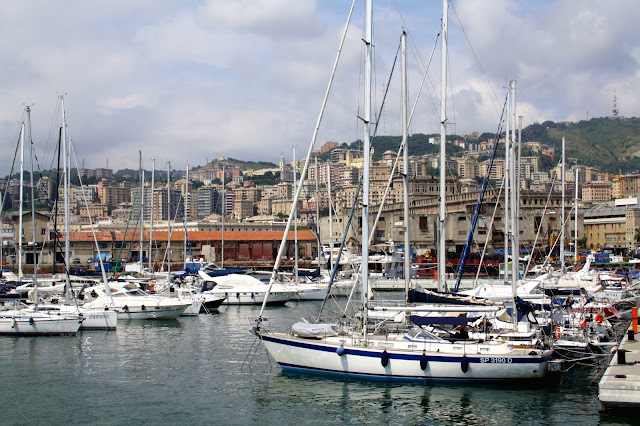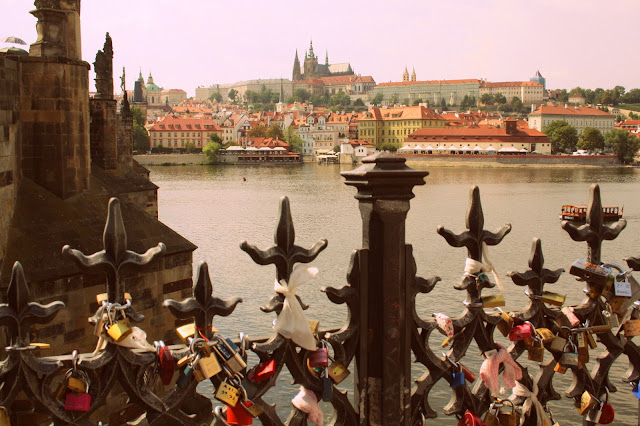"Chciałbym tu był przepędzić moją przeszłość" – Juliusz Słowacki w Rzymie/ "I wish I could spend here my past" – Słowacki in Rome
Któregoś dnia idąc rankiem do pracy przez via del Babuino, dostrzegłam
tabliczkę na budynku pod numerem 164 informującą, że w 1836 roku mieszkał tu Juliusz
Słowacki. Zauważyłam ją dopiero po kilku latach bywania w Rzymie. Rzym
nigdy nie przestaje zaskakiwać. Via del Babuino to bardzo centralne i
turystyczne miejsce. W gwarze i pośpiechu codziennego dnia tak wiele rzeczy
człowiekowi umyka.
W XIX wieku w okolicy Piazza di Spagna mieszkało wielu obcokrajowców, zwłaszcza tych przyjeżdżających z północy. Północna brama wjazdowa znajdowała się na pobliskim Piazza del Popolo. Słowacki przyjechał do Rzymu ze Szwajcarii w lutym 1836 r. Najpierw z Genewy dotarł do Marsylii, stamtąd parowcem przez morze do Livorno, następnie dyliżansem przez Civitavecchia do Rzymu. Spędził w tym mieszkaniu 3 miesiące.
During these three months, Słowacki visited the Vatican Museums, the Sistine Chapel, and climbed the dome of St. Peter's Basilica, which was not such a simple matter than:
"Yesterday I was on the dome of Saint. Peter and I climbed to the sphere under the cross, where 16 people can fit; the view of Rome from there is very beautiful, the entire roof of the church is similar to a colony, there are even a few craft houses and the fountain is still leaking; walking on it, man feels that he is not on earth but he experienced such an impression as walking on the deck of a ship; from there you go to the dome on very good stairs, without any danger, to the sphere itself one enters on the ladder..."
Romantics visiting Rome focused primarily on ancient ruins, looking for signs of former glory in them and contemplaiting the vanity of the world. However, quite recently, an additional place had appeared on the romantic map of the Eternal City - a Non-Catholic Cemetery:
Once I was walking down the Babuino
street, I have noticed the wall plaque on the building number 164, informing
that, Polish romantic poet, Juliusz Słowacki lived here in the 1836. I’ve
noticed it after several years spend in Rome Eternal City del
In the 19th
century many foreigners lived in the area of Piazza di Spagna, especially those
coming from the north. The northern entrance gate was located in the nearby
Piazza del Popolo. Słowacki came to Rome from Switzerland Geneva he reached Marseilles , from there he crossed the sea by steamship to
get to Livorno, then he took a stagecoach to reach Civitavecchia
and finally he came to Rome
Juliusz Słowacki, Rzym 1836
Poznał
tu Zygmunta Krasińskiego, Konstantego Danielewicza, Adama Sułtana i Stanisława
Sołtyka. Rzym go oczarował: „Jak dziwnie powietrze włoskie działa na moje zmysły, tego
ci opisać nie mogę; mam tysiąc zachceń, tysiąc wielkich podlotów do nieba,
chciałbym tu był przepędzić moją przeszłość” – pisał w liście do matki.
He met here
another Polish poets and artists like Zygmunt Krasiński, Konstanty Danielewicz,
Adam Sułtan and Stanisław Sołtyka. Rome
Jakob Alt, Rome from 1836
W trakcie tych trzech miesięcy Słowacki zwiedził
Muzea Watykańskie, Kaplicę Sykstyńską i wdrapał się na kopułę bazyliki świętego
Piotra, a nie była to wówczas taka prosta sprawa:
„...wczoraj byłem na kopule św. Piotra i wlazłem aż do
kuli pod krzyżem, gdzie 16 ludzi pomieścić się mogą; widok na Rzym stamtąd
bardzo piękny, cały dach kościoła podobny jest do jakiejś kolonii, nawet jest
kilka domków rzemieślniczych i fontanna ciągle cieknąca; chodząc po nim
człowiek czuje, że nie jest na ziemi i doznaje takiego wrażenia, jak chodzący
po pokładzie okrętu; stamtąd idzie się na kopułę na bardzo dobrych wschodach,
bez żadnego niebezpieczeństwa, do samej zaś kuli włazi się po drabinie…”
"Yesterday I was on the dome of Saint. Peter and I climbed to the sphere under the cross, where 16 people can fit; the view of Rome from there is very beautiful, the entire roof of the church is similar to a colony, there are even a few craft houses and the fountain is still leaking; walking on it, man feels that he is not on earth but he experienced such an impression as walking on the deck of a ship; from there you go to the dome on very good stairs, without any danger, to the sphere itself one enters on the ladder..."
Ippolito Caffi, Roma, Piazza San Pietro, 1836
Romantycy odwiedzający Rzym skupiali się przede wszystkim na starożytnych ruinach, szukając w nich śladów dawnej świetności i kontemplując fakt przemijalności świata. Jednak od całkiem niedawna pojawiło się dodatkowe miejsce na romantycznej mapie Wiecznego Miasta - Cmentarz protestancki:
„Byłem
niedawno na cmentarzu tutejszym angielskim, widziałem groby dwóch poetów, jeden
z nich kiedyś mógł być dla mnie przestrogą; młody Keats leży pod małym
kamieniem; ów poeta wydał kiedyś swoje wiersze, krytyka jednego z pism
angielskich zabiła go, to jest, dostał melancholii, potem suchot; pochowano go
w Rzymie; miło leżeć na takim cmentarzu, mały kwadratowy, pod piramidą
Ceskusza, dawnego Rzymianina… dokoła grobami zasiany, a te co są, ciche i z
białego marmuru, w jednym kącie cmentarza przezroczysty kląb cyprysów i innych
lekszych drzew, zupełnie jak gaik Elizejski w Eneidzie Wirgiliusza, po którym
błądzą cienie kochanków samobójców. Drugim śpiącym poetą na tym cmentarzu jest
Shelley, przyjaciel Byrona; bezbożny, utopił się, ciało jego spalono na stosie,
równiny nad morzem w Lido, prochy leżą na cmentarzu, lecz niespokojne, tablica
marmurowa pękła na dwoje, może jaki duch w bezksiążycowej nocy rozłamał ją na
dwoje i uniósł duszę poety.”
James A. Merigot, Pyramid of Cestius from 1791
Romantics visiting Rome focused primarily on ancient ruins, looking for signs of former glory in them and contemplaiting the vanity of the world. However, quite recently, an additional place had appeared on the romantic map of the Eternal City - a Non-Catholic Cemetery:
"I was recently at the English cemetery, I saw the
graves of two poets, one of them could have been a warning to me, young
Keats lies under a small stone; that poet once published his poems, the
criticism of one of the English magazines killed him, that is, he got
melancholy, than consumption; he was buried in Rome; it's nice to lie on
such a cemetery, small square, under the Pyramid of Cestius, former
Roman... tombs dotted around, and those who are, quiet and made of white
marble, in one corner of the cemetery there is a transparent cypress
flowerbed, just like Elysee grove in the Virgil's 'Aeneid', where the shadows
of suicided lovers are wandering.The other sleeping poet at this cemetery is
Shelley, a friend of Byron; godless, he drowned, his body was burned at
the stake, plains by the sea in Lido, the ashes lie in the
cemetery, but restless, the marble gravestone broke in two, maybe some
ghost on a moonless nigh broke her apart and lifted the soul of the poet."
RZYM
„Rzymie! nie jesteś ty już dawnym
Rzymem”.
Tak śpiewał pasterz trzód, siedząc na
koniu.
Sznury pałaców pod Apeninami,
Nad nimi kościół ten, co jest
olbrzymem.
Okrętów tłum jako łabędzie stado,
Które ogarnął sen pod ruinami.
I zdjął mię wielki płacz, gdy tą
gromadą
Poranny zachwiał wiatr i pędził dalej
Jakby girlandę dusz w błękitność bladą.
Ci aniołowie fal — a ja zostałem
W pustyni sam — z Rzymem, co już się
wali.
Jak wtenczas — gdy mię spytało w
pustyni










Komentarze
Prześlij komentarz